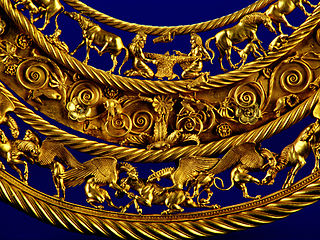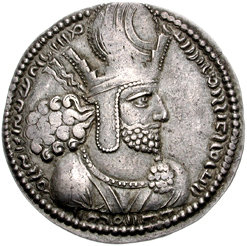
The Saffarid dynasty was a Muslim Persianate dynasty from Sistan that ruled over parts of eastern Iran, with its capital at Zaranj. Khorasan, Afghanistan and Sistan from 861 to 1003. The dynasty, of Persian origin, was founded by Ya'qub bin Laith as-Saffar, born in 840 in a small town called Karnin (Qarnin), which was located east of Zaranj and west of Bost, in what is now Afghanistan - a native of Sistan and a local ayyar, who worked as a coppersmith (ṣaffār) before becoming a warlord. He seized control of the Sistan region and began conquering most of Iran and Afghanistan, as well as parts of Pakistan, Tajikistan and Uzbekistan.

Gondophares I was the founder of the Indo-Parthian Kingdom and its most prominent king, ruling from 19 to 46. A member of the House of Suren, he belonged to a line of local princes who had governed the Parthian province of Drangiana since its disruption by the Indo-Scythians in c. 129 BC. During his reign, his kingdom became independent from Parthian authority and was transformed into an empire, which encompassed Drangiana, Arachosia, and Gandhara. He is generally known from the dubious Acts of Thomas, the Takht-i-Bahi inscription, and coin-mints in silver and copper.

Margiana is a historical region centred on the oasis of Merv and was a minor satrapy within the Achaemenid satrapy of Bactria, and a province within its successors, the Seleucid, Parthian and Sasanian empires.
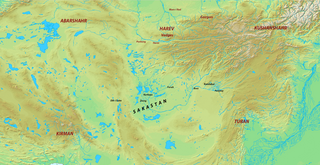
Sakastan was a Sasanian province in Late Antiquity, that lay within the kust of Nemroz. The province bordered Kirman in the west, Spahan in the north west, Kushanshahr in the north east, and Turan in the south east. The governor of the province held the title of marzban. The governor also held the title of "Sakanshah" until the title was abolished in ca. 459/60.

Mazun was a Sasanian province in Late Antiquity, which corresponded to modern day Bahrain, Qatar, United Arab Emirates, and the northern half of Oman. The province served as a Sasanian outpost, and played an important role in the Sasanian efforts to gain control over the Indian Ocean trade, and to establish their dominance in the wealthy regions of Hadramaut and Yemen.

Albania, or Ardhan in Parthian or Arran in Middle Persian, was a Caucasian satrapy (province) of the Sassanid Empire.

Meshan was a province of the Sasanian Empire. It consisted of the Parthian vassal kingdoms of Mesene and Characene and reached north along the Shatt al-Arab river and then the lower Tigris to Madhar and possibly further. Its inhabitants included Babylonians, Arabs, Iranians, and even some Indians and Malays. The province was very fertile, the best place for barley according to Strabo, and contained many date palms. It was also an important trading province along the Persian Gulf.
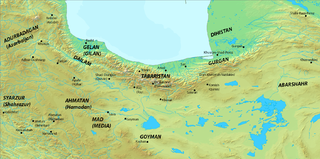
Abarshahr was a Sasanian province in Late Antiquity, that lay within the kust of Khorasan. The province bordered Media in the west, Hyrcania in the north west, Margiana in the north east, and Harev in the south east. The governor of Abarshahr is attested to have held the unique title of kanarang, distinguished from the title of marzban given to governors of frontier provinces.
House of Suren or Surenas are one of two Parthian noble families explicitly mentioned by name in sources dateable to the Arsacid period.

Ganzak, is an ancient town founded in northwestern Iran. The city stood somewhere south of Lake Urmia, and it has been postulated that the Persian nobleman Atropates chose the city as his capital. The exact location, according to Minorsky, Schippmann, and Boyce, is identified as being near Leylan, Malekan County in the Miandoab plain.

Padishkhwārgar was a Sasanian province in Late Antiquity, which almost corresponded to the present-day provinces of Mazandaran and Gilan. The province bordered Adurbadagan and Balasagan in the west, Gurgan in the east, and Spahan in south. The main cities of the province was Amol and Rasht.
Muslim conquest of Khorasan was the last phase of the heavy war between the Rashidun caliphate against Sassanid Empire.

Harev, was a Sasanian province in Late Antiquity, that lay within the kust of Khorasan. The province bordered Kushanshahr in the west, Abarshahr in the east, Marv in the north, and Sakastan in the south.
Rabi ibn Ziyad al-Harithi was an Arab military leader, who served the Rashidun and Umayyad Caliphates.
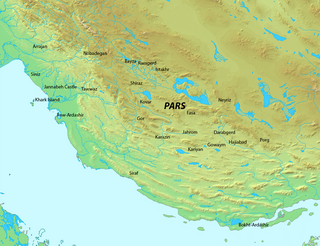
Pars was a Sasanian province in Late Antiquity, which almost corresponded to the present-day province of Fars. The province bordered Khuzestan in the west, Kirman in the east, Spahan in the north, and Mazun in the south.





